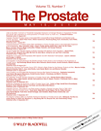Refining the orthotopic dog prostate cancer (DPC)-1 model to better bridge the gap between rodents and men
Abstract
BACKGROUND
Rodent models are often suboptimal for translational research on human prostate cancer (PCa). To better fill the gap with human, we refined the previously described orthotopic dog prostate cancer (DPC)-1 model.
METHODS
Cyclosporine (Cy) A was used for immune suppression at varying doses and time-periods prior and after orthotopic DPC-1 cell implantation in the dog prostate (n = 12). Follow up included digital rectal examination, ultrasound prostate imaging and biopsies of hypoechoic areas. At necropsy, the prostate, iliosacral lymph nodes (LN), lung nodules, and suspicious bone segments were collected for histopathology.
RESULTS
15 mg CyA/kg daily for 10 days was optimal for tumor take. Maintaining these conditions post-implantation resulted in a rapid tumor development within and beyond the prostate and in iliosacral LNs. To minimize tumor burden, 10 times less DPC-1 cells were implanted. A series of dogs was next followed for 3–4 months, under continuous immune suppression (n = 3) or with CyA interruption at 8.5 weeks (n = 2). In all instances, multifocal tumors were found within the prostate. Predominant patterns were micropapillary and cribriform. Metastases were present in iliosacral LNs and lungs. Moreover, pelvic bone metastases producing a mixed osteoblastic/osteolytic reaction were confirmed in two dogs, one per group. Lastly, the release of CyA 1–2 weeks post-implantation (n = 3) did not prevent tumor growth and spreading to LNs.
CONCLUSIONS
The continuing growth of DPC-1 tumors despite the release of CyA and, for the first time, spreading to bones renders this refined model closer to the spontaneous canine and hormone-refractory phase of human PCa. Prostate 72:752–761, 2012. © 2011 Wiley Periodicals, Inc.




